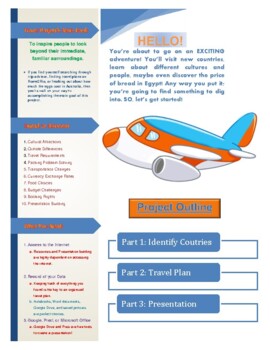World Travel Presentation: Geography, Economics, ELA Distance Learning Project
Jameson's History Department
66 Followers
Grade Levels
4th - 12th, Homeschool
Subjects
Resource Type
Standards
CCSS7.SP.A.1
CCSS7.SP.A.2
CCSS7.SP.B.4
CCSS7.NS.A.3
CCSSCCRA.R.1
Formats Included
- PDF
Pages
21 pages
Jameson's History Department
66 Followers
Description
***PLEASE REVIEW THIS PRODUCT***
Are you ready for your biggest adventure yet?
This product includes:
- Instructor and student guided lesson plan
- Travel project outline
- Specific resources
- Website directional instructions
- Custom graphic organizer printable templates
- Prezi account instructions
- Integrated subject learning: Geography, Economics, Mathematics, English, History, Technology, Health
- Deep learning, real world considerations
- Budgeting practice
- Creative writing story prompt
Use this product again and again! You'll never run out of ways to use the travel project!
Total Pages
21 pages
Answer Key
Does not apply
Teaching Duration
1 Week
Last updated Apr 1st, 2020
Report this resource to TPT
Reported resources will be reviewed by our team. Report this resource to let us know if this resource violates TPT’s content guidelines.
Standards
to see state-specific standards (only available in the US).
CCSS7.SP.A.1
Understand that statistics can be used to gain information about a population by examining a sample of the population; generalizations about a population from a sample are valid only if the sample is representative of that population. Understand that random sampling tends to produce representative samples and support valid inferences.
CCSS7.SP.A.2
Use data from a random sample to draw inferences about a population with an unknown characteristic of interest. Generate multiple samples (or simulated samples) of the same size to gauge the variation in estimates or predictions. For example, estimate the mean word length in a book by randomly sampling words from the book; predict the winner of a school election based on randomly sampled survey data. Gauge how far off the estimate or prediction might be.
CCSS7.SP.B.4
Use measures of center and measures of variability for numerical data from random samples to draw informal comparative inferences about two populations. For example, decide whether the words in a chapter of a seventh-grade science book are generally longer than the words in a chapter of a fourth-grade science book.
CCSS7.NS.A.3
Solve real-world and mathematical problems involving the four operations with rational numbers.
CCSSCCRA.R.1
Read closely to determine what the text says explicitly and to make logical inferences from it; cite specific textual evidence when writing or speaking to support conclusions drawn from the text.





